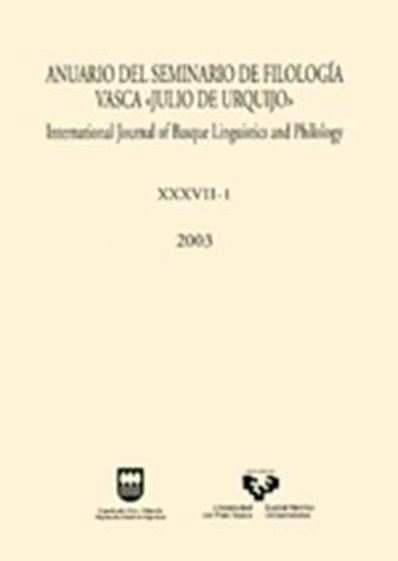Hitz-konposakera euskaraz eta aitzin-euskaraz
##plugins.themes.bootstrap3.article.main##
##plugins.themes.bootstrap3.article.sidebar##
Argitaratua
2003-04-05
Mikel Martínez
Laburpena
Lakarra's explanation of pre-proto-Basque (1995), according to which the canonical word was monosyllabic at a very early time, brings very important consequences to the reconstruction of the language and offers us new ways of understanding the possible development of the morphological structure in earlier phases prior to the time for which Michelena reconstructs his well-known system. Following Lakarra's views, in this paper we try to set out an explanation of how Michelena's morphological system came about and which types of compouds and/or nominal phrases may have existed in each period.
A great deal of non-compound words that can be reconstructed for proto-Basque are disyllabic. These are monolexematic in historical Basque, but the linguist's diachronic insight can lead us to split both syllables into two elements which recur across the lexicon and whose meaning can be at least hinted. According to the «micro-syntax» they display, we think these compouds were of five types: a) descriptive: with a «noun-adjective» micro-syntactical structure (gi-bel «liver», or-katz «roe-deer»); b) dependent: with a «noun-noun» structure (zu-bi «bridge», os-tots «thunder»); c) suffixed: with a «noun-suffix» structure (harr-i «stone», han-di «big»); d) coordinative: with a «noun-noun» or «noun-noun» structure in which normally both nouns keep some logical relation with the semantic head in a coordinative way (gi-zen «fat», gi-zon «man»); e) reduplicative: with a «noun-noun» or «adjective-adjective» structure, in which a marked meaning is added to the non-reduplicative counterpart (go-go «soul», ze-zen «bull»).
Some morpho-phonemic considerations lead us to the conclusion that in these disyllabic compounding constructions the accent fell on the second syllable. This, along with an observation of the semantic interrelation of the two members of these disyllabic compounds (redundant in some cases), suggests that the prolification of disyllabic words may have been motivated by prosodic factors. Thus, word-formation would have been a transit from a (quasi-)monosyllabic phase into another phase in which nominal phrases, specially those with either a singulative or a specifying meaning, tended to build yambic feet (in its intensive sense) and develop a demarcative accent, which due to its disyllabic structure could be interpreted ambiguously: as deuterotonic (stress on the second syllable from the left) or hysterotonic (stress on the first syllable from the right).
All these disyllabic units came about as nominal phrases which were interpreted analytically. But afterwards this analytic meaning was lost and the units were lexicalized. The resulting meaning could be endocentric or exocentric, nominal or adjectival. Disyllabic roots came about in this way. From that moment on, in order to build compounds it was necessary to adjoin two disyllabic roots, and in this manner tri- and tetrasyllabic units arose. As the demarcative frame of the accent was expanded, the ambiguous accent-rule was interpreted as deuterotonic (stress on the second syllable from the left), but compounds had a special rule: stress on the first syllable of the second member.
A great deal of non-compound words that can be reconstructed for proto-Basque are disyllabic. These are monolexematic in historical Basque, but the linguist's diachronic insight can lead us to split both syllables into two elements which recur across the lexicon and whose meaning can be at least hinted. According to the «micro-syntax» they display, we think these compouds were of five types: a) descriptive: with a «noun-adjective» micro-syntactical structure (gi-bel «liver», or-katz «roe-deer»); b) dependent: with a «noun-noun» structure (zu-bi «bridge», os-tots «thunder»); c) suffixed: with a «noun-suffix» structure (harr-i «stone», han-di «big»); d) coordinative: with a «noun-noun» or «noun-noun» structure in which normally both nouns keep some logical relation with the semantic head in a coordinative way (gi-zen «fat», gi-zon «man»); e) reduplicative: with a «noun-noun» or «adjective-adjective» structure, in which a marked meaning is added to the non-reduplicative counterpart (go-go «soul», ze-zen «bull»).
Some morpho-phonemic considerations lead us to the conclusion that in these disyllabic compounding constructions the accent fell on the second syllable. This, along with an observation of the semantic interrelation of the two members of these disyllabic compounds (redundant in some cases), suggests that the prolification of disyllabic words may have been motivated by prosodic factors. Thus, word-formation would have been a transit from a (quasi-)monosyllabic phase into another phase in which nominal phrases, specially those with either a singulative or a specifying meaning, tended to build yambic feet (in its intensive sense) and develop a demarcative accent, which due to its disyllabic structure could be interpreted ambiguously: as deuterotonic (stress on the second syllable from the left) or hysterotonic (stress on the first syllable from the right).
All these disyllabic units came about as nominal phrases which were interpreted analytically. But afterwards this analytic meaning was lost and the units were lexicalized. The resulting meaning could be endocentric or exocentric, nominal or adjectival. Disyllabic roots came about in this way. From that moment on, in order to build compounds it was necessary to adjoin two disyllabic roots, and in this manner tri- and tetrasyllabic units arose. As the demarcative frame of the accent was expanded, the ambiguous accent-rule was interpreted as deuterotonic (stress on the second syllable from the left), but compounds had a special rule: stress on the first syllable of the second member.
Nola aipatu
Martínez, Mikel. 2003. «Hitz-Konposakera Euskaraz Eta Aitzin-Euskaraz». Anuario Del Seminario De Filología Vasca "Julio De Urquijo" 37 (1):1-84. https://doi.org/10.1387/asju.8853.
##plugins.themes.bootstrap3.article.details##
Zenbakia
Atala
Artikuluak
Lan hau Creative Commons Aitortu-EzKomertziala-LanEratorririkGabe 4.0 Nazioartekoa lizentzia baten mende dago.


